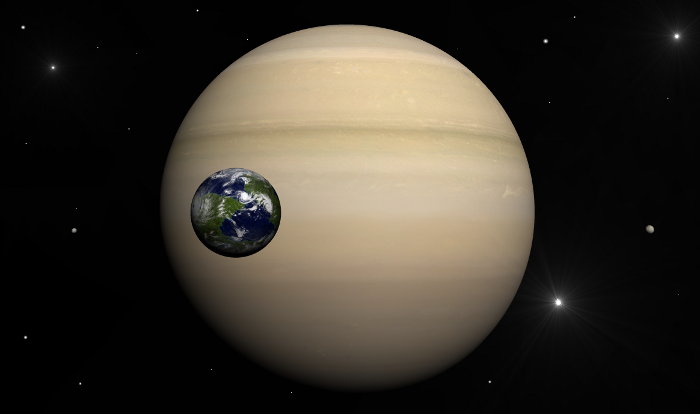A Little FT3 Magic - So Many Worlds To See (A Mini Gallery)!
 Terraformer_Author
Newcomer
Terraformer_Author
Newcomer
Hi Y'all!!!
Well, I am now hitting here and there a little book project that I am working on half heartedly at present that I might include in T1.0 (when it gets finished - or started - whatever the case may be), and I have been doing artwork for it - of course - using FT3, as well as BRYCE, and a slew of other resources. Here are a few examples of what I have completed thus far, and please - no wagering...
First in our cavalcade of new images is a depiction of an Earth like moon orbiting a warm Carbon Dioxide / Hydrogen Gas Giant in the Goldilocks Zone of a nice "G" type star:
Well, I am now hitting here and there a little book project that I am working on half heartedly at present that I might include in T1.0 (when it gets finished - or started - whatever the case may be), and I have been doing artwork for it - of course - using FT3, as well as BRYCE, and a slew of other resources. Here are a few examples of what I have completed thus far, and please - no wagering...
First in our cavalcade of new images is a depiction of an Earth like moon orbiting a warm Carbon Dioxide / Hydrogen Gas Giant in the Goldilocks Zone of a nice "G" type star:



Comments
However, I think the objects are a bit too close to each other to be sustainable. For instance, the earth and the moon (roughly 13,000 km and 3,500 km diameter respectively) are around 360,000 km apart (larger masses would be much further apart), which would look something like this:
I have the Bryce scenes saved and can tweak them later.
http://www.latimes.com/business/technology/la-fi-tn-scientists-billions-of-habitable-planets-20120328,0,7725764.story
also, in your 7th picture (the one that uses Jupiter as the gas giant) I really like that it has a shadow from one of the moons cast on its surface, and how you seemed to place the smaller world in juuuussst the right spot to accent it (or I could be seeing things that aren't there...)
Great Job!
Keep Calm
and
Map On
Yeah - actually judging from the fact that there are probably TRILLIONS of galaxies out there - even "billions" of other "Earths" might be an understatement. Lol.
I don't like just "making up stuff off the cuff" when I do something like this - but rather than whip out my Physics and Pre-Calculus text books and dig into them for just a brief outline like these are - I'll make an educated guesstimate. If I wanted to "flesh it out", and really refine that particular model, for example - if it were the setting for a game campaign or something - then I'de trim away the fat on it and give it rock solid stats. If any stats in the descriptions seem "screwy" - then mathematical corrections are certainly welcome, lol.
All of these scenarios are scientifically sound however - and are definitely possible. I like awsomely cool yet possible, which is why although I love the fantasy genre - I'm more of a sci-fi dude (yep - unicorns are possible - but only with highly complicated genetic engineering - and a horse acting as a surrogate, lol).
Also - the images are mine - but since the "concepts" that the images portray are actual possibilities and not contrived - then you guys can use them (the CONCEPTS) as a basis for whatever game worlds and fiction that you can come up with. These are illustrations / simulations of general principles - not specific fictional or real places.
If you want to use my images - ask my permission first. Since Profantasy is hosting my stuff here - then naturally they can use these images for promotional or other purposes - just like the images in the Terraformer package. These images will also be used in any books, products, or projects that I might do later on. Private stock fodder. You guys can use these to generate ideas for places and cosmologies for your game and fiction settings - sorta like picking out the right color of house paint I guess, lol.
Question...Are these images technically maps - or are they more like diagrams?
SOFTWARE USED:
Fractal Terrains 3 with Terraformer,
Universe, by Diard Software (free shareware version - for nebula effects and starfield compositing), starfields are pretty easy to do with a wide variety of techniques other than using Universe, but I'm lazy, lol.,
Bryce 7 (any version of Bryce will do actually),
The GIMP (Supernova and Lens Flare Filters and additional painting and editing),
Microsoft Paint (For image pasting and additional editing).
I remember reading somewhere the Moon will one day be in a fixed orbit around Earth (as it is moving away from us about an inch a year, yes I did know this before Terra Nova was on TV), there won't be a moon-rise or set, it will be in one position. I always thought that would be a strange, one side of the planet would have an always visible moon and the other would never know of it.